Adventures in Conservation: Convicts with Knives
In 2005, Judy Joyce and I were working on an erosion control project on the banks of Clear Creek. We decided on cordgrass, also called sloughgrass, for the most vulnerable locations because it forms a dense deep sod. This native enjoys routine flooding, and with its own aeration system can root 2-5 feet deep in saturated soil, a rare capability.
A downside to cordgrass is that most of its seed is not viable. Paul Christiansen said that it is a pollination problem, plus tiny insect larvae eating their way through viable seed. Our solution to using it was to transplant small dormant sod chunks. A large donor patch was located on the floodplain a half-mile away.
In order to cover a large area with closely spaced sod pieces, we needed a lot of manpower. However, Oakdale Prison is only a few miles away and we borrowed the services of about eight inmates for a week. These fellows were considered reliable and they had all showed interest in working outdoors.
So on the appointed morning, a large van drove up with our team, and an armed guard. He initially seemed mellow in his role, until I opened a box and handed out knives with foot-long serrated blades. At which point he stepped back a bit, presumably to assure that no one could get behind him.
We got down to business, which consisted of me using my narrow long-bladed sharp shovel to slice out sod slabs about 18” x 18” x 3”. These were handed off to the knife guys who cut them into 3x3x3 bricks, and then packed them into sturdy trays, and loaded them into a pickup or a small boat. The boat was our access to the north side because the onramp from I-380 onto I-80 cuts off vehicle access to the floodplain.
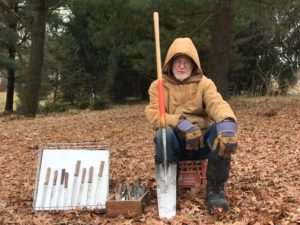
The knives, shovel, and a sample tray.
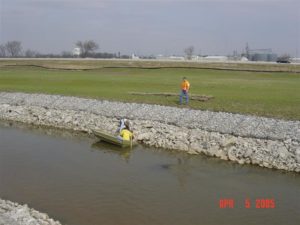
Unloading a boatload of trays from harvest on other side of creek.
The sod pieces were planted on the tilled floodplain just behind the rock gabions.
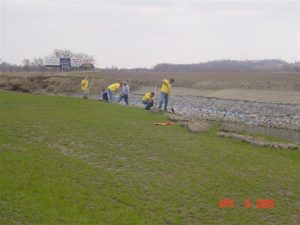
Planting sod chunks, trays on right.

The blue flags helped keep transplants properly spaced.

Newly planted sod chunks, complete with weeds.
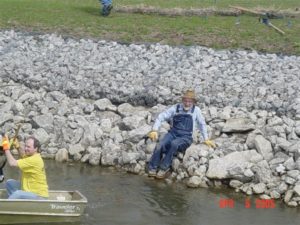
I’m grinning because I don’t have to plant them all by myself.
We were all well-behaved, and the guys did indeed enjoy working outdoors, and the whole planting project got off to a good start. Early summer was a little skimpy on rain, but Coralville came through with a Parks employee and a pump, and revived the sods with a drink from the creek.
By the following summer, most of the sods had sprawled out, were developing a substantial root system, and some were flowering.
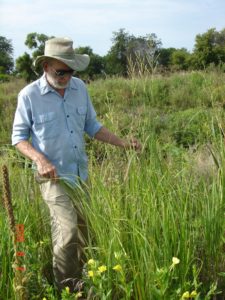
Growth of prairie cordgrass sod, second season.
Tags: habitat restoration, Lon Drake


